Karel Kuttelwascher was the most successful Czechoslovak fighter pilot during the Second World War. Since the beginning of October 1941, he served in No. 1 Squadron where he gained all his victories. Almost all of them while flying Hurricane Mk.IIC BE581
Into dark night without a radar
No. 1 Squadron used Hurricanes Mk.IIc since the middle of 1941 and its pilots trained night flying intensively to prepare to fight German night Blitz, still problematic since the end of the Battle of Britain. Before the radar-equipped night fighter became a standard, RAF tried different methods of defence. The easiest one was to change a day fighter squadron into night fighter and sent its pilots for lone night patrols.
The ground control was not often precise and a Hurricane pilot hunting at night for German bombers mainly had to take pot luck and trust his senses. However, the sight was not always the most important of them. Pilots often mentioned that the reaction of their aircraft for turbulences caused by enemy aircraft helped them to discover it. At the beginning of 1942, RAF decided to extend the ineffective tactics of destroying enemy bombers on their way to targets and started attacking enemy planes in and around their bases. The RAF had tried it earlier, but a relatively short range of British fighters limited the tactics effectively.
Hurricane Mk IIc – myśliwiec na każdą porę, w nocy i w dzień
Karel Kuttelwascher’s Hurricane
We can find the history of Kuttelwascher’s achievements in many books. Instead of describing this great pilot’s victories, I will focus on his mount, its history and markings. I will present arguments to prove that, as of today, this is the most likely reconstruction of Hurricane BE581 from May 1942. It was the time of Kuttelwascher’s biggest successes in fighting against the ongoing German offensive, known as the “Baedeker Blitz”.
We could have decided to give you Kuttelwaschers earlier aeroplane, Hurricane MK.IIc s/n BE150, which also had an individual letter “E” that, however, failed before 12th December 1941. When it returned from the Hawker factory after repairs, it received an individual letter “F”. On 28th December No.1 Squadron received another Hurricane Mk.IIC s/n BE581. Kuttelwascher flew this most famous intruder fighter for the first time on 2nd January 1942 and, until 8th July, almost throughout his service in the “Number One” squadron, it was Czech ace personal aircraft.
Colour profile of Hurricane Mk IIc, BE581/JX-E in January 1942, Karel Kuttelwascher personal aeroplane according to photo: IWM, CH 92326. Artwork by Zbyszek Malicki.
Kuttlewascher Hurricane IIc colours
First lifery of the BE581 with A-type roundels on fuselage isn’t mistery. It was prepared on the basis of photo from January 1942 available in IWM resources (HU 92326). It would be an easy bit for modeller, but it was repainted before Kuttelwascher started his incredible bight fighter score.

18-inch low visibility, night fighter fuselage roundels implemented in February 1942, with the row of swastikas under the canopy seems to be more attractive for every modeller. However, apart from victory markings, the reconstruction bases on intermediate sources as there are not any photos showing the whole BE581 with such markings. However, there are photos of other aeroplanes from the unit and Jiri Sebek’s superb work published in the Czech magazine “Letectví a kosmonautika” 1/2019, written in cooperation with R. Darlington (the author of Kuttelwascher’s biography “Night Hawk”) and other historians. This article was a starting point for our work. Very helpful were also the following books: N. Franks and M. O’Connor “Number One in War and Peace” and P. Caygill’s “In all things first: No.1 Squadron at War 1939-45”.
Camouflage
The BE581 was built in the last weeks of 1941 and went to the 29 MU (Maintenance Unit), where it was adapted to a night fighter duties. It limited to painting the plane with a deep matt Special Night RDM 2 paint. Probably the first layer was DTD 308 paint, satin black with a navy blue hue.
When it left the factory, the plane was in a Temperate Land Scheme camouflage that had been replaced in August 1941 by a new Day Fighter Scheme, but Hawker continued painting Hurricanes according to the former almost until the end of the year. It was only at the Maintenance Unit that the planes received camouflage adapted to their tasks. The colour photo of BE500 (IMW, COL 186) serving in No. 87 Squadron shows clearly the Dark Earth colour showing through the night camouflage. It is significant if we want to know what the plane looked like during its line service as some parts, such as the rudder trim and the rudder horn balance, were not painted in black. We can also see the lack of black paint on the rudder horn balance in the photos of machines from No. 87 Squadron (IMW, CH 4259). I do not know for sure the reason for doing so. I suppose that painting the trimmers with two coats of paint may have raised concerns about the proper operation of these delicate devices, and the extra weight of the paint could rebalance the rudder. The lack of painting on its upper front parts is a trace of this operation. I take it as a hypothesis, as I have nowhere found a credible explanation. The photos of the JX-J / BD949, shot down on 12th February during Operation Fuller, show that the elevator trimmers are also not black (probably Sky on the undersides) and the rudder horn trim is not the same colour as the red part Flash’s Fin.

In Jiří Šebek’s reconstruction, this element is shown as red, and here our interpretations differ. Another difference is the visibly brighter antenna mast. It remained painted in Dark Earth, or even in the colour of the material, i.e. wood, quite similar in colour to DE.
The second modification for night flights was covering the exhaust manifolds with a special HTP (High-Temperature Paint 41) paint, which in practice eliminated their unfavourable glow, that not only hindered the pilot’s observation but also exposed him to the enemy. With the use of this paint, there was no need to install the exhaust glare covers, popular on Hurricanes from that period, and you can not see them in any photo of the machines used by the No. 1 Squadron. We described the colour of this paint as “Dirty Orange”. There is probably no modelling paint equivalent to the original HTP 41, and it needs to be improvised. In my opinion, the colour of this paint we can describe as something between bright orange and brick red. Its shade could also change in service because it was not particularly durable.
Markings

 We recreated the shape of the code letters basing on the only photo of the left side of Kutellwascher’s Hurricane (IWM, CH 92326). We noticed some irregularities. The letters on the right are painted according to the regulations, so do not change their sides. The letter “E” is narrower, 18 inches wide. The red colour of the letters was introduced simultaneously with the 18-inch diameter roundel and the Fin Flash of the same height. The photos of BD949 and Sgt Ernie Glover standing by his aeroplane, found in P. Caygill’s book were also helpful here.
We recreated the shape of the code letters basing on the only photo of the left side of Kutellwascher’s Hurricane (IWM, CH 92326). We noticed some irregularities. The letters on the right are painted according to the regulations, so do not change their sides. The letter “E” is narrower, 18 inches wide. The red colour of the letters was introduced simultaneously with the 18-inch diameter roundel and the Fin Flash of the same height. The photos of BD949 and Sgt Ernie Glover standing by his aeroplane, found in P. Caygill’s book were also helpful here.
The introduction of national markings with a smaller diameter (let me remind you that this is the beginning of February 1942), left a circle of fresh black paint around the new roundel, with the diameter of the old 35-inch one. This difference gradually faded during operation and should not be visible three months later.
There was a bright/white badge on the left side of the fuel tank. I suspect that there was the information on how to use or disassembly of the tank. I have not found a close-up of this element anywhere, and it would be slightly unprofessional to give some fake or indistinct text. This item has been omitted. If anyone has a photo of this mysterious badge, I would be grateful for sharing it. We will be able to add it in the next products.
Long Range modification
In my opinion, the aircraft underwent modification to the Long Range (LR) version while in service with the unit. Good evidence may be the fact that the plane disappeared from the ORB in early March. Meanwhile, Kuttelwascher flew two other Hurricanes. He returned to the cockpit of the BE581 on 25th March and immediately made a two-hour flight on it, which is longer than the flight duration of the serial machine. Previously, no other aircraft of the unit had flown for more than 1.5 hours. The tanks extended the patrolling time to over 3 hours. There is no hard evidence that external fuel tanks were installed in March, but the history of 87 Squadron I have examined earlier confirms that these modifications to the night Mk.IIc were not introduced until the spring of 1942. Intruder flights into French territory began soon afterwards. And it is this increase in range that was the basis of Kuttelwascher and his colleagues’ overnight successes. Since then, the Luftwaffe airfields were within reach of intruders, and from April they began to be regularly visited by aggressive, deadly guests.
 The modification to the LR standard reduced the maximum speed, already lowered by deep matt paint, and the installation of external tanks which could not be jettisoned. The external feature that distinguishes fixed tanks from jettisoned ones is the lack of a fuel filler cap on the former. Apart from the fuel system installation, the design of the ammunition belt links chutes of the internal cannon also required changes. It was moved to the empty shell chute. Later, this modification was implemented on the production line. The Arma Hobby set has these chutes in the appearance typical for the production of 1941. Those of you who attach importance to detail can improve this by extending the existing opening towards the case chute (see picture left).
The modification to the LR standard reduced the maximum speed, already lowered by deep matt paint, and the installation of external tanks which could not be jettisoned. The external feature that distinguishes fixed tanks from jettisoned ones is the lack of a fuel filler cap on the former. Apart from the fuel system installation, the design of the ammunition belt links chutes of the internal cannon also required changes. It was moved to the empty shell chute. Later, this modification was implemented on the production line. The Arma Hobby set has these chutes in the appearance typical for the production of 1941. Those of you who attach importance to detail can improve this by extending the existing opening towards the case chute (see picture left).
In the manual, we did not mark the IFF system antennas, which were on both sides, between the fuselage and the horizontal stabilizers.
We assumed that in January 1942 version, the propeller spinner was yellow, although we cannot eliminate the possibility that it was painted Sky. There was a tradition in the squadron that aeroplanes in each Flight wore flight colours. This custom continued during Kuttelwascher service. The spinner colour changed to red after he bacame the “A” Flight commander on 17th February 1942. The oral testimony of unit mechanic, Don Parks, recorded by R. Darlington, is the only proof that confirms the propeller spinner colour. There is no material proof, but there is no proof otherwise. So there was no reason to give up making uniform painting more attractive.
The same witness, however, ruled out that Kuttelwascher’s plane had any personal markings. The “Night Reaper” attributed to him, supposedly painted on the right side of the engine cowling, is literary fiction and an unauthorized association of Kuttelwascher with the emblem of J. M. Crabb’s JX-U / BE572. Besides, all the personal markings known to me were painted on the left side of the fuselage in No.1 Squadron.
Reconstruction of Hurricane Mk IIc BE581/JX-E markings in “Night Intruder” configuration, May1942. Artwork by Zbyszek Malicki.
The same case is with the painting scheme worn by PZ865 in the Battle of Britain Memorial Flight in 2005-2010. No.1 Squadron Hurricanes received the Day Fighter Scheme camouflage after the Kuttelwascher left the squadron and there was no black on the lower surfaces. The unit soon stopped using the Hurricanes. On 21st July 1942, the first Hawker Typhoon Mk.Ib appeared in the squadron. From September, it operated on new fighters. The last five Hurricanes Mk.IIc (and one Mk.IIb) preserved until 6th September 1942, are immortalized in a famous series of photos showing them flying in formation. Our BE581 is no longer there.
Last six Hurricanes Mk II b/c from 1 Squadron RAF Day Fighter coliur scheme, August/September 1942.
Further service
On 14th August 1942, the BE581 was transferred to No. 486 Squadron, where it was used for training. At the end of August, we can find it in No. 253 Squadron, where he made his last operational flight on the night of August 28/29 in the company of Havoc Turbinlite, and finally went to No. 532 Squadron and was only used for training there. In this unit, on the night of 7th November 1942, it ended his existence after damage sustained during a forced landing.
After the course of further service, we can assume that it remained in his usual black paint until the end
English translation by Dominik Sędziak
Karel Kuttelwascher aerial Victories Claimed in RAF service
From Roger Darlington Night Hawk website (see links below)
| Date | Aircraft | Status | Place |
|---|---|---|---|
| 2 February 1941 | Messerschmitt Bf 109 | Probable | Boulogne |
| 8 April 1941 | Messerschmitt Bf 109 | Destroyed | Near Cap Gris Nez |
| 21 May 1941 | Messerschmitt Bf 109 | Destroyed | Between Calais and Dunkirk |
| 27 June 1941 | Messerschmitt Bf 109 | Destroyed | Le Touquet |
| 1/2 April 1942 | Junkers Ju 88 | Destroyed | Melun |
| 1/2 April 1942 | Junkers Ju 88 | Damaged | Melun |
| 16/17 April 1942 | Dornier Do 217 | Destroyed | St André |
| 26/27 April 1942 | Dornier Do 217 | Destroyed | Rouen-Boos |
| 26/27 April 1942 | Junkers Ju 88 | Damaged | Rouen-Boos |
| 30 April/1 May 1942 | Dornier Do 217 | Destroyed | Rennes |
| 30 April/1 May 1942 | Heinkel He 111 | Destroyed | Dinard-coast |
| 4/5 May 1942 | Heinkel He 111 | Destroyed | St André |
| 4/5 May 1942 | Heinkel He 111 | Destroyed | St André |
| 4/5 May 1942 | Heinkel He 111 | Destroyed | St André |
| 2/3 June 1942 | Dornier Do 217 | Destroyed | Off Dunkirk |
| 3/4 June 1942 | Heinkel He 111 | Destroyed | St André |
| 3/4 June 1942 | Dornier Do 217 | Damaged | St André |
| 3/4 June 1942 | Dornier Do 217 | Destroyed | St André |
| 21/22 June 1942 | Junkers Ju 88 | Destroyed | St André |
| 21/22 June 1942 | Junkers Ju 88 | Damaged | St André |
| 28/29 June 1942 | Dornier Do 217 | Destroyed | Near Trévières |
| 1/2 July 1942 | Dornier Do 217 | Destroyed | Near Dinard |
| 1/2 July 1942 | Dornier Do 217 | Damaged | Near Dinard |
| 1/2 July 1942 | Dornier Do 217 | Destroyed | Near Dinard |
You may be interested:
- Hurricane Mk II b/c model with Karel Kuttelwascher markings link
- Jiří Šebek “Letectví a kosmonautika” 1/2019
- The Czech Night Hawk by Roger Darlington – website link
Model maker for 45 years, now rather a theoretician, collector and conceptual modeller. Brought up on Matchbox kits and reading "303 Squadron" book. An admirer of the works of Roy Huxley and Sydney Camm.
This post is also available in:
 polski
polski


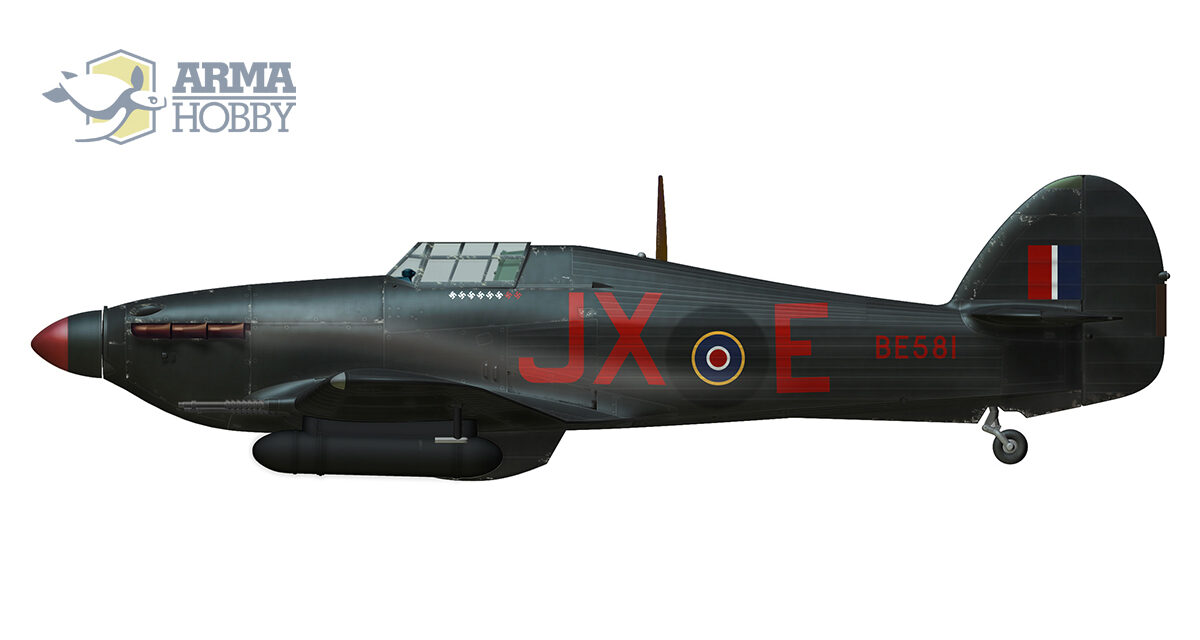







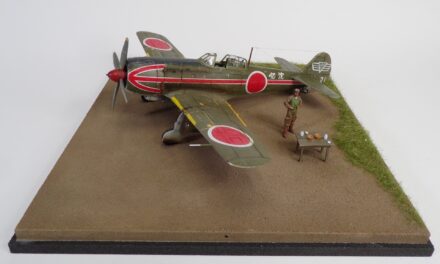
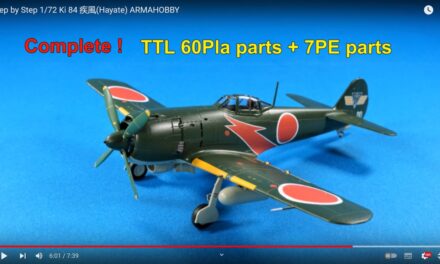
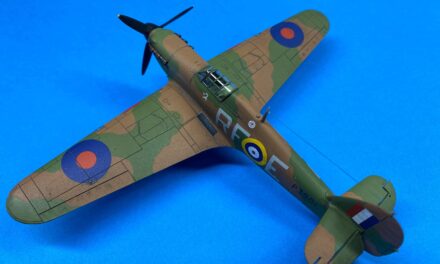
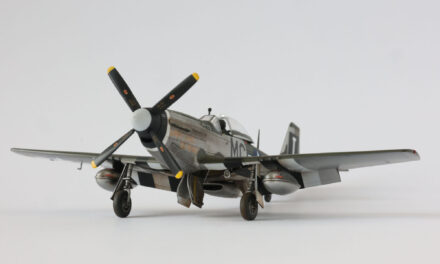
I finally found a picture of this mysterious badge on the tank. It will have to be added in the next projects